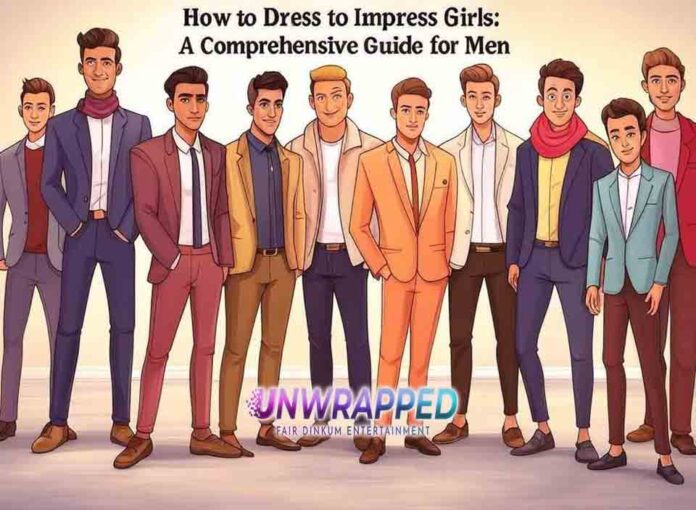First impressions are pivotal, and attire plays a significant role in how one is perceived. For men aiming to capture attention and make a lasting impact, dressing appropriately is essential. It’s not merely about following fleeting fashion trends but understanding the nuances of style, fit, and personal grooming that collectively enhance one’s appeal.
This guide delves into the art of dressing to impress, offering insights into wardrobe essentials, grooming habits, and the psychology behind fashion choices. By embracing these principles, men can project confidence and sophistication, qualities that are universally attractive.
Page Contents
ToggleThe Psychology of Dressing Well
Clothing serves as a non-verbal communicator, conveying aspects of personality, status, and confidence. Studies suggest that individuals often make judgments within seconds of an encounter, with attire being a primary influencer. Dressing well not only affects how others perceive an individual but also impacts self-esteem and behavior.
Key Takeaways:
First Impressions Matter: Attire significantly influences initial perceptions.
Self-Perception: Dressing well can boost confidence and positively affect behavior.
Non-Verbal Communication: Clothing choices convey messages about personality and status.
Wardrobe Essentials to Elevate Style
Building a versatile wardrobe is foundational to dressing impressively. Key pieces serve as the backbone of various outfits suitable for different occasions.
1. Well-Tailored Suit
A classic, well-fitted suit exudes sophistication and is indispensable for formal events. Opt for neutral colors like navy or charcoal for maximum versatility.
2. Crisp White Dress Shirt
A staple that pairs seamlessly with suits or can be dressed down with jeans, offering a clean and polished look.
3. Dark Denim Jeans
A pair of dark, well-fitting jeans provides a balance between casual and refined, suitable for various settings.
4. Quality Footwear
Shoes are often noticed first. Investing in classic styles like oxfords or loafers in brown or black leather is advisable.
5. Versatile Blazer
A blazer can elevate a casual outfit, adding a touch of formality without being overly dressy.
6. Neutral T-Shirts and Polo Shirts
High-quality basics in neutral colors serve as the foundation for numerous casual ensembles.
7. Chinos
An alternative to jeans, chinos offer a slightly dressier look while maintaining comfort.
8. Classic Watch
A timeless timepiece adds a subtle touch of elegance and attention to detail.
9. Leather Belt
Coordinating the belt with shoe color provides a cohesive and polished appearance.
10. Outerwear
Depending on the climate, a tailored overcoat or a stylish leather jacket can complete an outfit.
Another Must-Read: How Excavator Hires Can Keep You Out of Trouble
The Importance of Fit
Regardless of the quality or brand, ill-fitting clothes can undermine the entire look. Ensuring that garments fit well enhances appearance and comfort.
Tips:
Tailoring: Invest in tailoring to adjust off-the-rack items for a custom fit.
Proportions: Clothing should complement body shape without being too tight or overly loose.
Length: Pay attention to sleeve and trouser lengths to maintain a sharp silhouette.
Color Coordination and Patterns
Understanding color theory and pattern mixing can elevate style and create visually appealing outfits.
Guidelines:
Neutral Base: Build outfits around neutral colors (black, white, gray, navy) for versatility.
Accent Colors: Incorporate pops of color through accessories or statement pieces.
Patterns: Mix patterns cautiously; ensure they complement rather than clash.
Seasonal Considerations: Lighter colors for spring/summer and darker tones for fall/winter.
Grooming: The Complement to Dressing Well
Attire and grooming go hand in hand. Neglecting personal hygiene can detract from even the most impeccable outfit.
Key Areas:
Haircare: Regular trims and a hairstyle that suits face shape.
Facial Hair: Maintain beards or mustaches neatly; clean-shaven looks should be smooth.
Skincare: A routine that addresses individual skin needs promotes a healthy complexion.
Nail Care: Clean, trimmed nails reflect attention to detail.
Fragrance: A subtle, pleasant scent can leave a lasting impression.
Accessories: The Finishing Touches
Accessories can enhance an outfit when chosen appropriately.
Suggestions:
Ties and Pocket Squares: Add personality to formal wear.
Cufflinks: Offer a touch of elegance to dress shirts.
Bags: A quality leather briefcase or messenger bag combines functionality with style.
Eyewear: Frames that complement face shape can be both practical and fashionable.
See Also: The Art of Saying No: Prioritizing Your Well-Being
Footwear: Foundation of a Good Outfit
Shoes can make or break an ensemble. Investing in quality footwear is crucial.
Essential Styles:
Oxfords: Ideal for formal occasions.
Loafers: Versatile for both casual and semi-formal settings.
Sneakers: Clean, minimalist designs suitable for casual wear.
Boots: Offer rugged elegance, especially in cooler months.
Dressing for the Occasion
Adapting attire to suit the context demonstrates social awareness and respect.
Contexts:
Formal Events: Suits or tuxedos as appropriate.
Business Casual: Blazers with chinos or dark jeans.
Casual Outings: Well-fitting t-shirts or polos with jeans or shorts.
Dates: Outfits that balance comfort and style, tailored to the venue.
Common Mistakes to Avoid
Even with the best intentions, small missteps in fashion can undo a strong first impression. Recognizing these pitfalls and proactively avoiding them is a key part of dressing to impress.
Fashion Faux Pas to Steer Clear Of:
Over-accessorizing: While a watch or necklace can add character, too many accessories can distract and create a cluttered look.
Wearing wrinkled or dirty clothes: Presentation is everything. Clean, well-maintained clothes show care and discipline.
Poor footwear choices: Wearing running sneakers with dress pants or scuffed shoes can drastically downgrade an outfit.
Ignoring seasonal appropriateness: Heavy layers in summer or linen in winter can appear mismatched and impractical.
Logos overload: Excessive branding can come off as trying too hard. Understated style often leaves a better impression.
Dressing Based on Body Type
Dressing to impress also involves embracing one’s unique physique. Understanding body type helps in choosing outfits that highlight strengths and flatter proportions.
Style Tips by Body Type:
Tall and Slim: Layering can add dimension. Opt for double-breasted jackets or horizontal stripes to balance proportions.
Shorter Frames: Avoid overly baggy clothing. Choose well-fitted outfits with vertical lines to elongate the silhouette.
Muscular Builds: Select stretch fabrics and avoid overly tight clothes that restrict movement or exaggerate bulk.
Larger Builds: Dark colors and simple patterns can create a slimming effect. V-necklines help elongate the neck and torso.
Fashion should be a tool of empowerment, not discomfort. Learning to dress for one’s build is a sign of self-respect—and it’s something others will notice instantly.
Cultural and Situational Sensitivity in Style
Impressing someone goes beyond aesthetics; it’s about social awareness. Understanding cultural expectations or fashion norms in specific settings can set someone apart for all the right reasons.
Considerations Include:
Dress codes: When attending events, following the dress code (like “cocktail,” “black tie,” or “smart casual”) shows attentiveness and class.
Cultural appropriateness: In multicultural environments, being mindful of attire that could be considered offensive or out of place demonstrates emotional intelligence.
Global fashion awareness: Knowing the difference between what’s trendy in Tokyo’s streetwear scene versus Parisian classicism can enhance fashion fluency and global appeal.
Celebrity Style Icons for Inspiration
Looking to style icons is a smart way to build a fashion playbook. These figures don’t just dress well—they influence entire industries with their appearance.
Notable Figures to Watch:
David Beckham: Known for his ability to blend casual with tailored sophistication.
Timothée Chalamet: An avant-garde dresser with a unique twist on formalwear and bold fashion statements.
Idris Elba: Combines masculine elegance with urban flair.
Ryan Gosling: Often seen in minimal, perfectly-fitted pieces, demonstrating that less is more.
For further style cues, platforms like GQ and Esquire frequently break down celebrity wardrobes and offer real-world application tips.
Call to Action
If this guide helped refine your sense of style or offered new insights into dressing with confidence, share it with your friends or on your favorite social platform. Got a favorite brand or grooming tip that turns heads every time? Join the conversation in the comments and let the community know what works for you.
Dressing to impress isn’t about perfection—it’s about intention. And the more you learn and experiment, the more your personal style will begin to shine.
Conclusion
Dressing to impress girls isn’t about being flashy or spending extravagantly. It’s about presenting oneself with care, confidence, and intention. By investing in key wardrobe staples, understanding fit, grooming diligently, and dressing contextually, any man can project a magnetic presence.
Ultimately, style is a reflection of personality. While trends come and go, authenticity and attention to detail remain timelessly attractive. Dressing well isn’t about pretending to be someone else—it’s about showing the best version of yourself. And that’s always impressive.
People Also Love: The Electrician’s Guide to a Fully Equipped Toolbox










